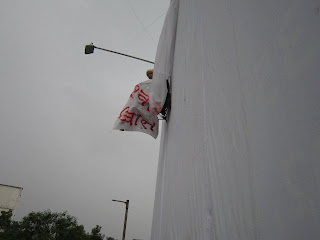"Seeds" is a public-interactive art project taken up by Jinal Patel.
The artist asks the village children to collect some seeds and give the artist and the artist generates a workshop of toy-making out of the seeds. The children made toys and dolls with animals and other natural forms covering the seeds with cow dung and mud. Notably the covering increased the life or vitality of the seeds for longer time. And on a particular day all the children went to a field and threw the seeds up randomly with a possibility leaving out there: of sprouting, uprising and being full-grown trees someday somehow.
More than the life, earth and seeds the project is also about randomness, speculations and possibilities.
"It is very interesting to me", Jinal Says, "to see how the forest is developed- by itself, without plantation: without plan, without care". The randomness of the natural forests insisted the artist to think about the project in one hand, and on the other a concern around the village-children of the upcoming generation who are seemingly tend to get away from the cultural, social and ecological roots inspired her to develop the project with seeds.
The throwing of the toys (or the seed-balls so to speak) randomly has greater significance in multiple ways. They were expected to grow up in the future- sometime, somewhere, somehow. This also addresses a critical dialogue around spectatorship or the act of perceiving an art work: where the artist or performer performs an art work for some imaginary spectator amongst the crowd expecting the communication to grow: sometime, somewhere, somehow.
"Seeds", the artist's intervention was collaborated with the performative venture "Jhini Jhini Chadaria", taken place on 18th June, 2014, in the "Eco-sani-irri" residency program by Gram Art.
Here is the transcription of the artists' sayings from the video updated below.
As Jinal says about her project:
"It is very interesting to me to see how the forest is developed- by itself, without plantation: without plan, without care. (In my thought it was there)- I was going to a farmer's village, I was thinking of plantation and farming... (and what I have come to realize that) the kids are not so much interested in farming. They are more into other things like Mobile and other urban stuff.
And I asked also so many children while working with them: Do you know where seeds come from?
Where you can find seeds and where not? What sprouts?
Somewhere they didn't know what a seed is. (I realized that) I should start with this. I told them to gift me one seed each, and they gifted me. With cow dung and earth we made some toys with animals and fish and natural forms.
And we decided to collaborate with a performance... it was a procession...
It was interesting to collaborate with the last day procession where we were carrying all the things and going to the houses asking some donations and giving something back- so it's a give-and-take - and that is how I thought about this whole project: as give-and-take to nature.
We went to the field, the children whoever made the seed-balls... They threw them to the field - back to the nature, so it will grow somewhere. It is a possibility which you are throwing, and you are giving it back what nature has given to you- somewhere in the time."


.JPG)


.JPG)
.JPG)
.JPG)
.JPG)
















































